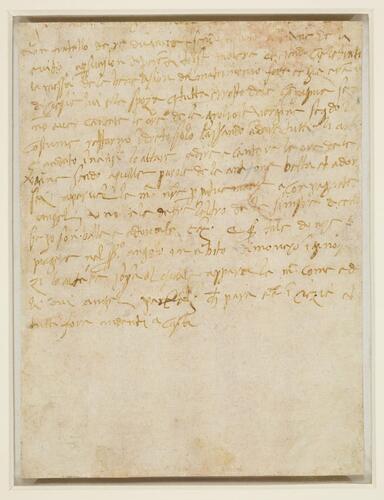-
1 of 253523 objects
St Anselm appearing to the Abbot Helsin during a storm at sea c. 1532-34
Red chalk (two shades), stumped and washed over in places | 21.3 x 16.0 cm (sheet of paper) | RCIN 990601
-
A study for the fresco by Anselmi in the Oratorio della Concezione in Parma, decorated between 1532 and 1534 with the assistance of Francesco Maria Rondani. It corresponds with one of the four pendentives (triangular panels) below the dome of the oratory, and shows St Anselm, Archbishop of Canterbury (d. 1109), appearing in a vision to Helsin, Abbot of Ramsey, during a storm at sea. There are significant differences between the drawing and the painting, in which St Anselm appears standing on the waves before the boat, and the indeterminate background seen here has become a remarkably ambitious panoramic seascape. The scene as painted is conceived as a fictive shaped panel, ‘supported’ by figures seated in the upper corners of the pendentive.
The celebration of the Immaculate Conception of the Virgin was both controversial and of confused origins. There is some evidence that in England the festival was celebrated during Saxon times and suppressed on the Norman invasion. The first reinstitution of the festival was at Ramsey in Kent around 1070, as promised by the abbot Helsin when his ship, on a voyage from Denmark, was saved from a storm by the appearance of an angel. This vision was described in several sources, including the Roman breviary of 1473, though the Feast Day of the Immaculate Conception was not formally adopted by the Roman church until 1476. A separate tradition, promulgated by the Council of Canterbury in 1325, attributed the re-establishment of the festival to St Anselm. This seems to have been a confusion with St Anselm’s nephew, also called Anselm, who as Abbot of Bury St Edmunds was an enthusiastic proponent of the feast early in the twelfth century. There was also a spurious letter in circulation, purportedly written by St Anselm, that described Helsin’s vision.
On the verso is a long inscription, cut and difficult to read, that describes a miracle of the Virgin in one of the other pendentives of the oratory.
The drawing was initially catalogued by Popham (in P&W) as Anonymous Parmese, but he subsequently recognised Anselmi's authorship and the connection with the Oratorio: 'Catalogue of drawings by Michelangelo Anselmi', Correggio's Drawings, 1957, pp. 169-72, no. 18. See also D. DeGrazia, Correggio and his Legacy, exh. cat., Washington, D.C., 1984, no. 63; M. Clayton, The Art of Italy in the Royal Collection: Renaissance and Baroque, exh. cat., London 2007, no. 41; D. Ekserdjian, Correggio e Parmigianino, exh. cat., Rome 2016, no. 84.Provenance
Listed in George III's 'Inventory A', c.1810, p. 123, Coreggio Parmegiano &c, 'A Saint working a Miracle at Sea...Coreggio, or after him'.
-
Creator(s)
-
Medium and techniques
Red chalk (two shades), stumped and washed over in places
Measurements
21.3 x 16.0 cm (sheet of paper)
Category
Object type(s)
Other number(s)
RL O : Royal Library "O" Number Register – RL O601Alternative title(s)
St Anselm appearing to the Abbot Helsin

